Advancing the Challenges of Tall Building Design Coupled with Seismic Issues
The Emerald City has its share of hidden passages and mysterious dark alleyways, but it is no secret that Seattle, Washington, is a metropolis on the move. According to census data released in August 2021, the city’s population grew by 21 percent over the previous decade to 737,015 people, with tech giants like Amazon, Google, and Microsoft bringing people to the area by the tens of thousands.
While tech may be one of the city’s biggest draws, its 200 miles of shoreline and breathtaking views of Mt. Rainier make the area a truly magnificent place to settle down, but the region’s unique topography has a darker side, as well. Seattle sits atop a basin of sedimentary soil directly above the Seattle Fault Zone. The zone, which extends from east to west through the middle of the city, is vulnerable to shallow earthquakes that can cause devastating effects near the earth’s surface. These unique tectonics challenge structural engineers to pioneer new techniques to ensure that tall building designs meet the demands of forces at work down below.
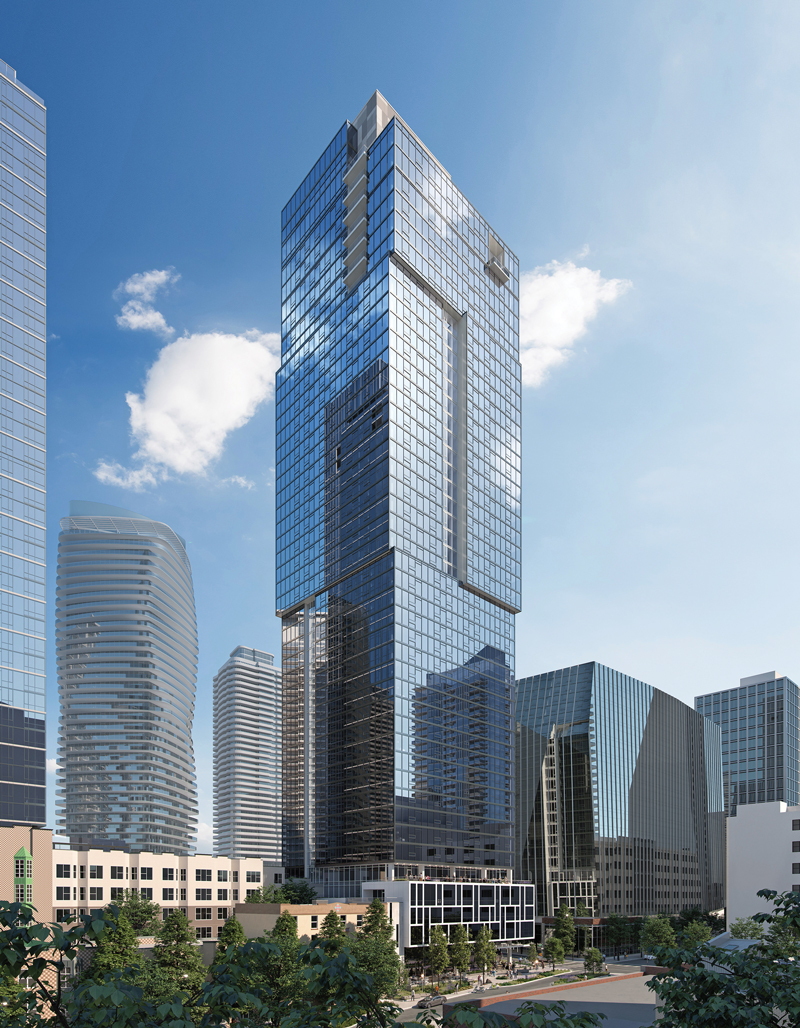
Brief Background
To augment the city’s revered Cornish College of the Arts and meet the growing demand for upscale urban living in 2018, developer Holland Partner Group purchased the school’s former Centennial Labs building, a 14,400-square-foot site at the corner of Virginia Street and Terry Avenue. The firm then assembled a team to design and construct The Ayer, a 45-story mixed-use building on the prime corner lot at 1000 Virginia Street. The team leaders included Seattle architects Weber Thompson and Bellevue, Washington-based CKC Structural Engineers. Once completed in Spring 2023, the Ayer will feature 454 residential units, three above-grade parking levels, and six below-grade parking levels to accommodate 242 motorized vehicles and 397 bicycles.
Inspired by the unique tectonics of the Pacific Northwest, The Ayer’s visual energy derives from its façade of fractured sheer concrete blocks and geometric patterning. In addition to a year-round rooftop deck and other community-focused amenities, the tower design boasts a non-traditional porch at grade to encourage communal connectivity and activation. With The Ayer set far back from the street, the resulting reimagined “porch” provides ample space and encourages interaction amongst the residents and people in the community who are just passing by.
Project Challenges
Even with a solid plan and team of seasoned experts, constructing a 480-foot tower with best-in-class seismic considerations is no small feat. The design and construction team faced several challenges, not the least of which was trying to fit a 600,000-square-foot tower into the confines of a sloped postage stamp site. The site measured 120 feet by 120 feet and featured a near 20-foot drop over a 120-foot run from its northeast corner to its southeast corner. In addition, the foundation and shoring system at the north property line faced problematic conditions with an occupied mid-rise residential building just a few inches away. With a typical tower floor plate of 11,000 square feet, the Ayer’s limited floor area created a challenge for engineers to equip the tower with a structural lateral system that would adequately resist seismic and wind forces and maximize the architectural program efficiency. Finally, the tectonic sheered façade created different residential floor plates with variable cantilevers. These cantilevers, combined with the stringent deflection requirements for the window wall system, posed an interesting balancing act between the ceiling height and controlling deflections. The design team met this challenge by designing an innovative slab column layout.
Tower Lateral Design
In The Ayer tower, a centrally located concrete core that wraps around the elevators and stairs helps meet interstory drift, strength, and serviceability requirements. CKC structural engineers performed sensitivity studies on wall thickness, concrete compressive strength, and concrete modulus of elasticity to enhance the concrete core performance. They also thoroughly analyzed the coupling beam locations, sizes, and frequencies to maximize ductility. This resulted in a core aspect ratio of roughly 14 to 1 and a coupling beams aspect ratio of 3 to 1. The concrete core wall thickness telescopes throughout the tower height to improve the architectural layout, increase leasable space and reduce concrete material and mass. The wall thicknesses vary between 33 and 21 inches and occur at levels 24, 30, and 40.
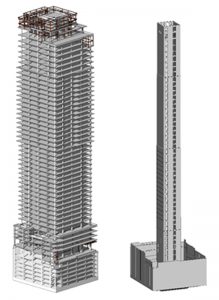
The team analyzed this lateral system using a three-dimensional Performance-Based Design (PBD) analysis model. The model integrated the nonlinear properties of critical elements in the concrete core, such as coupling beams and the yielding of wall vertical reinforcement. Structural engineers subjected the lateral model to two sets of 11 pairs of conditional mean spectrum-scaled ground motions. They scaled for the short and the long period of the target spectrum per ASCE 7-16, Minimum Design Loads and Associated Criteria for Buildings and Other Structures, Section16.2.1.2. This approach generally results in more realistic loading and a more efficient structural design. In addition to the nonlinear modeling, parametric studies on the foundations led to the use of soil springs to better represent the soil-structure interaction. This helped mitigate the moment demands on the tower’s foundation mat.
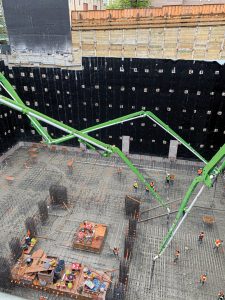
One of the unique features of The Ayer’s concrete core is its use of high-strength steel fiber-reinforced concrete (SFRC) coupling beams. The beam design featured a lower dosage of steel fiber reinforcement than previous tower applications like the Kiara tower (STRUCTURE, June 2019). While Kiara used 200 pounds per cubic yard of steel fiber dosage, The Ayer used 170. The team achieved this reduction in fiber reinforcement application by using the latest SFRC testing conducted by the University of Wisconsin and published in the Pankow Foundation Report (December 2016). CKC engineers calibrated the backbone curve of the SFRC coupling beam used in the PBD model using the test data for coupling beams with Bekaert Dramix 3D 55/30 steel fibers at 170 pounds per cubic yard. This lower dosage fiber beam helped improve cost and concrete workability. Moreover, the SFRC coupling beams were optimized and placed them only at floors above the dynamic base up to the main roof slab. For below-grade coupling beams and rooftop penthouse coupling beams where shear/rotational demands are low, the design used conventionally reinforced coupling beams to allow the use of the concrete wall mix design in the beam.
Used in combination, lower dosage SFRC coupling beams and the introduction of conventionally reinforced coupling beams where high shear and rotation demands are not present helped create cost efficiencies and sped up The Ayer’s core construction.
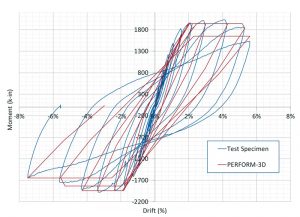
Gravity System
The Ayer’s state-of-the-art structure consists of cast-in-place concrete with post-tensioned floor slabs and a shear wall core for seismic and wind resistance. The gravity system utilizes long-span, 8-inch-thick post-tensioned flat plate slabs with perimeter cantilevers that extend up to 12 feet on the east side of the building. This resulted in 16 columns and zero transfer conditions, making way for fewer columns, optimized slab-bending moments, and reduced floor-to-floor height with thinner slabs.
The column placement strategically limits the number of columns per floor, eliminates the need for deep transfer beams above the dynamic base, and uses gravity to help resist overturning lateral forces. Close collaboration with the architectural team and strategic column walks and rotations along the building height helped thread 16 columns over the 480-foot height of the tower. This approach also eliminated the need for transfer beams that would otherwise have been required to shift column locations at levels where occupancies change. In addition, columns stand a distance away from the concrete core to increase the floor tributary area supported by the concentric core. Thus, most of the building’s dead load is transferred to the core, minimizing net tension in the walls from overturning due to wind and seismic forces.
The Ayer features post-tensioned, 8-inch-thick flat-plate slabs at typical residential levels, including the subterranean parking, creating flexible interior space with open layouts. At subterranean levels, shotcrete perimeter basement walls follow the construction of the slabs. This allowed slab shortening to occur before shotcrete wall construction. The team also poured subterranean levels against the shoring piles to provide bracing and allow the de-tensioning of tiebacks prior to placing shotcrete walls. This approach eliminated the need for tieback blockouts in the basement wall, which are a constant water penetration problem.
A Marriage of High-Strength Materials
The Ayer is a prime example of how the strategic, targeted use of high-strength materials can significantly improve structural efficiency as well as the architectural layout and the construction schedule. Column loads for a building the size of The Ayer can be in the order of 3,500 kips of allowable axial loads. A concrete compression strength of 15,000 psi was specified for the tower columns at the lower levels. The ability to specify high-strength concrete reflects steady advances in concrete materials technology. This “super concrete” allows for fewer and smaller columns per floor plate, maximizing interior unit layout and formwork productivity. The column concrete strength reduces from 15,000 psi at the base to 8,000 psi at the upper levels. This allows column sizes to remain constant almost to the top of the tower, maximizing formwork productivity and helping maintain a rapid construction pace.
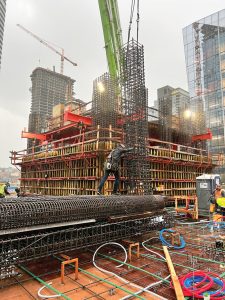
In addition to the high-strength concrete mix, The Ayer takes full advantage of the latest ACI 318-19, Building Code Requirements for Structural Concrete and Commentary, high-strength reinforcement as outlined in Table 20.2.2.4(a) of the code. The team used A706 Grade 80 rebar in the foundations and all shear wall reinforcement. This resulted in significant cost savings since the 10 percent price premium for Grade 80 versus Grade 60 was offset by the 20 to 25 percent reduction in foundation and shear wall rebar tonnage. The design also used Grade 80 for all column ties to satisfy the stringent seismic confinement reinforcing requirements for ultra-high-strength concrete. The synergistic combination of high-strength reinforcement, high-strength concrete in the columns, and high-strength steel fibers in the coupling beams resulted in construction and cost efficiencies throughout the project.
Constructability Journey
Constructability thinking is a mindset that complements every decision, from the conceptual layout to the selection of the structural system to construction. The Ayer embodies the impact of constructability in improving construction productivity and structural efficiency. The successful implementation of constructability ideas was made possible with close communication between the design and construction team members.
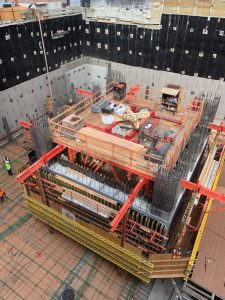
The team worked closely from the early design phase to create a one-of-a-kind building that expresses the architectural intent and is also poised to achieve the project budget and construction schedule. Early buildability meetings between CKC and Conco, the concrete subcontractor responsible for the structural frame construction, focused on subterranean construction from mat foundation reinforcement placement to sequencing basement walls and elevated slabs. Those early discussions also made it possible to streamline the reinforcement of the core wall detailing to ensure compatibility with the self-climbing formwork system. Moreover, working closely with the architect to thread columns throughout 45 stories without introducing deep transfer beams had a significant positive impact on improving structural efficiency. Another example of constructability was the elimination of puddling at high-strength concrete columns. Prior to pouring slab concrete, the team wrapped Stay-form around the column tie perimeter through the depth of the slab. A cost-effective concrete forming system that does not require stripping after the concrete form, the Stay-form prevented slab concrete from flowing into the column core during the slab pour. When the column pours followed, column concrete flowed into these penetrations. The addition of shear-friction rebar through the slab/column joints in both directions supplemented the connection strength. This emphasis on constructability and its central role in the tower’s structural design and detailing created synergy between the design and construction team.
Conclusion
Once it is complete, The Ayer will be a significant addition to the expanding downtown Seattle landscape, one that will stand up to whatever the city’s growth and Mother Nature have in store. Its success was made possible by the latest advancements in seismic design and the implementation of constructability through collaborative work between all the team members involved.■
Project Team
Owner: Holland Partners
Structural Engineer: CKC Structural Engineers
Architect: Weber Thompson
Contractor: Holland Construction
Concrete Subcontractor: Conco
